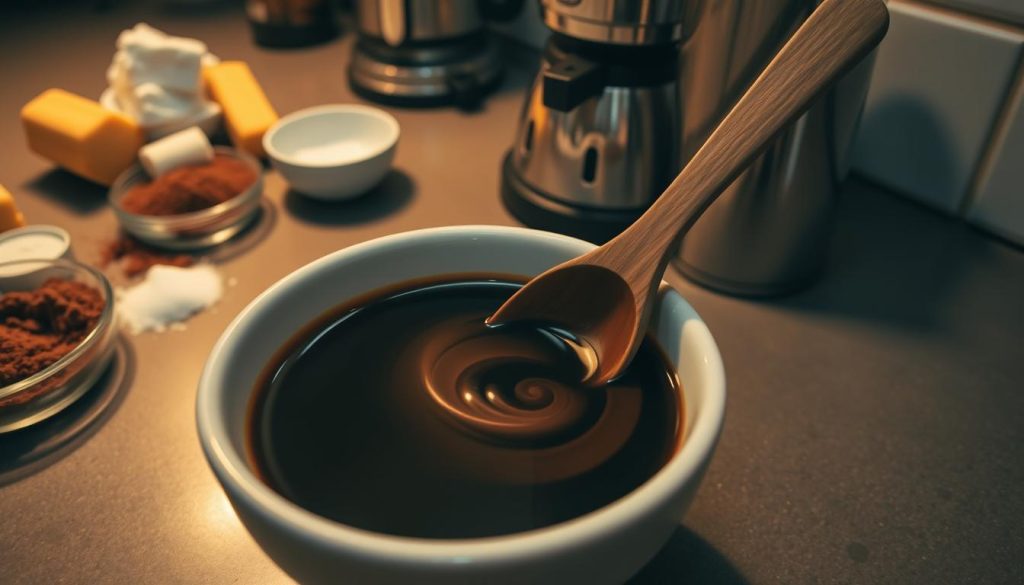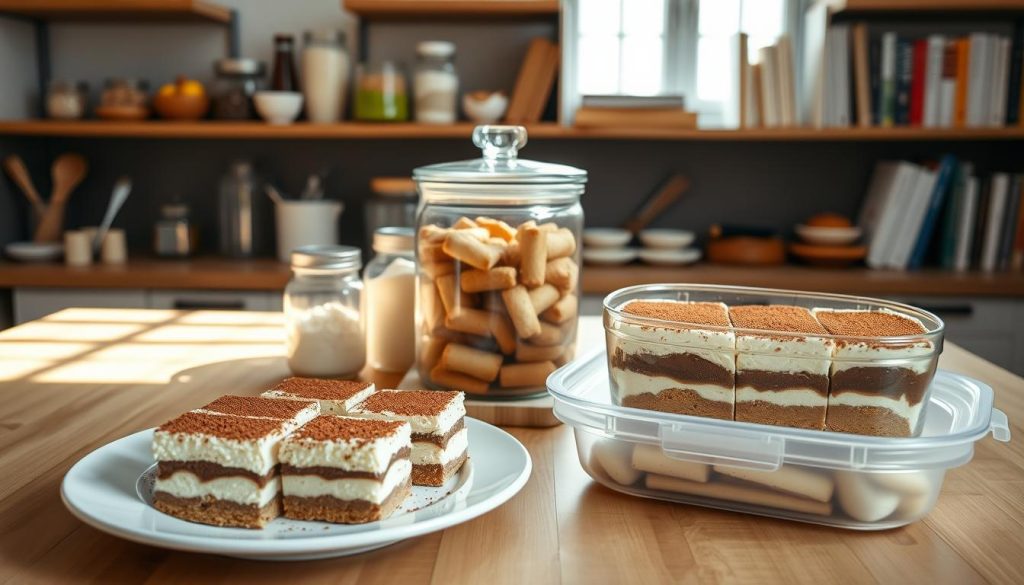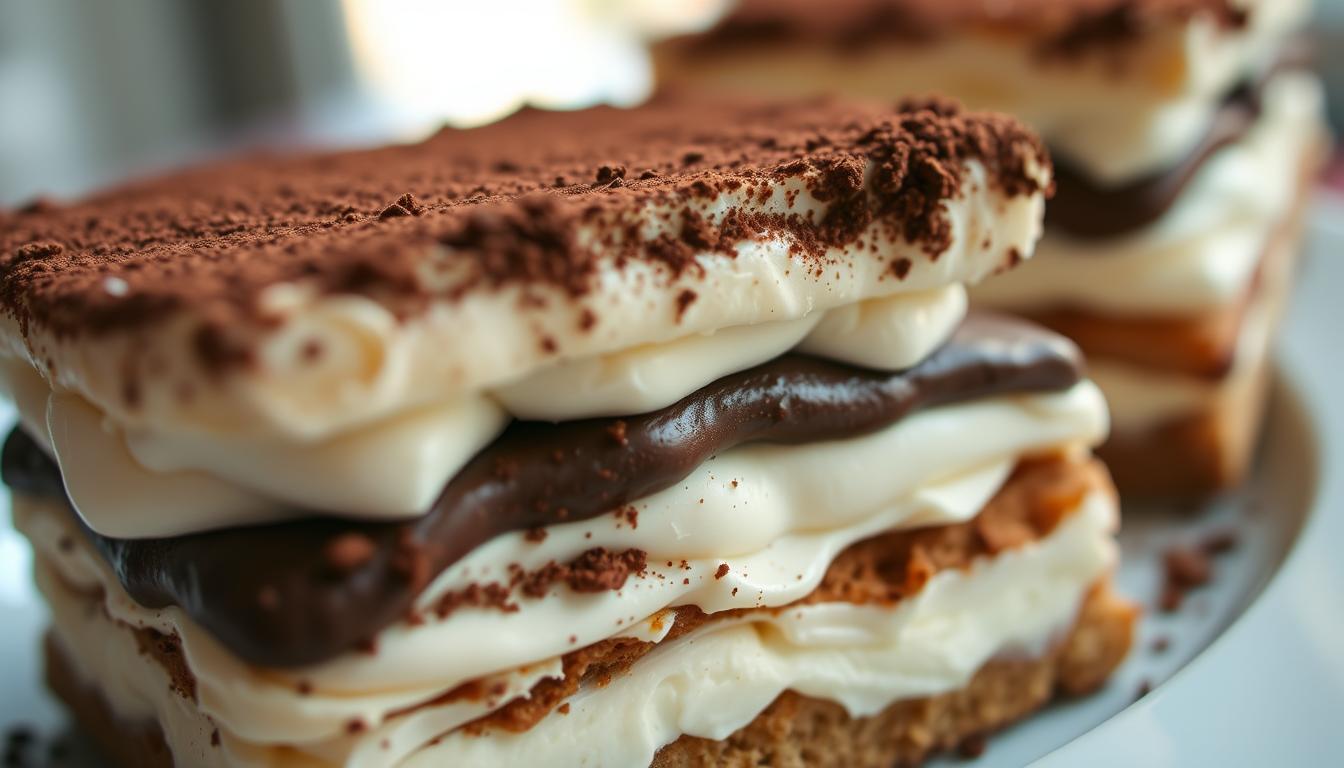Classic Tiramisu: Authentic Italian Dessert Recipe
Welcome to the world of authentic Italian desserts! Today, we’re diving into a beloved classic that has captured hearts and taste buds around the globe. Say hello to the Classic Tiramisu, a dessert that embodies the essence of Italian tradition with its rich, creamy, and light texture.
This iconic dessert is more than just a treat; it’s a journey through layers of espresso-soaked ladyfingers and a luxurious mascarpone cream. What makes this recipe truly special is its deep roots in Italian culinary history, perfected through generations of family recipes and expert insights.
While it may seem decadent, this Classic Tiramisu is surprisingly simple to prepare. The key lies in the quality of its ingredients—mascarpone cheese, fresh eggs, and a hint of vanilla. These elements come together to create a dessert that’s both elegant and approachable, perfect for any occasion.
Key Takeaways
- Classic Tiramisu is a traditional Italian dessert known for its creamy texture and coffee flavor.
- The recipe features layers of espresso-soaked ladyfingers and mascarpone cream.
- Quality ingredients like mascarpone, eggs, and vanilla are essential for an authentic taste.
- Despite its rich appearance, the dessert is relatively easy to make at home.
- It’s a perfect choice for special occasions or as a indulgent treat.
Introduction to Classic Tiramisu
Step into the enchanting world of Italian desserts, where every bite tells a story. Tiramisu stands out as a beloved treat, cherished for its layers of espresso-soaked lady fingers and a creamy mascarpone mixture. This dessert is a masterclass in balance, blending the boldness of coffee with the sweetness of mascarpone.
A key element that elevates this dessert is the dusting of cocoa powder. It’s not just a topping; it’s what gives Tiramisu its iconic look and a touch of bitterness to offset the sweetness. Fresh egg yolks are another crucial component, creating a custard base that’s both rich and silky. These ingredients come together to craft a texture that’s nothing short of divine.
When preparing this dessert, it’s essential to make sure you’re using authentic lady fingers. These delicate biscuits are designed to soak up just the right amount of espresso without becoming too soggy. You can find them in most Italian grocery stores or well-stocked supermarkets. Remember, every step in the process matters, so make sure each layer is carefully constructed to ensure the best flavor and texture.
| Component | Role | Importance |
|---|---|---|
| Cocoa Powder | Topping | Adds visual appeal and flavor contrast |
| Egg Yolks | Custard Base | Creates a smooth, creamy texture |
| Lady Fingers | Structure | Provides the dessert’s framework and absorbs espresso |
History and Origin of Tiramisu
Discover the fascinating journey of Tiramisu, a dessert that has traveled from its humble beginnings in Italy to become a global phenomenon. This beloved treat has a rich history that reflects the culinary ingenuity of Italian culture.
Cultural Roots and Italian Traditions
Tiramisu, which translates to “pick-me-up” in Italian, is believed to have originated in the Veneto region. The dessert gained popularity in the mid-20th century, quickly becoming a staple in Italian restaurants. Its creation is often attributed to Carminantonio Iannaccone, a chef from Rome, who crafted it in the 1960s.
The traditional mixture of mascarpone cheese, espresso, and cocoa powder laid the foundation for its distinctive flavor. Over time, the recipe evolved, with the addition of sugar to balance the bitterness of the coffee and cocoa. Each ingredient plays a vital role in creating the dessert’s signature taste and texture.
Historically, Italian desserts often featured layered structures, and Tiramisu is no exception. The layers of coffee-soaked ladyfingers and mascarpone cream represent a perfect harmony of flavors and textures. This structure has remained unchanged, even as the dessert has gained international acclaim.
One interesting historical note is the use of cocoa powder as a topping, which not only adds visual appeal but also enhances the flavor profile. The careful balance of sugar and coffee ensures that each bite is both sweet and tangy, making Tiramisu a timeless favorite.
Essential Ingredients for Classic Tiramisu
Crafting the perfect Tiramisu begins with selecting the finest ingredients. Each component plays a vital role in achieving the dessert’s signature taste and texture.
Key Components: Mascarpone, Eggs, and Coffee
The foundation of Tiramisu lies in its key ingredients. Mascarpone cheese is essential for the creamy texture, while fresh eggs add richness. Coffee, preferably espresso, provides the distinctive flavor. Cocoa powder is used for dusting, enhancing both appearance and taste.
Ingredient Tips and Substitutions
For the best results, use high-quality mascarpone and keep it chilled until use. Opt for fresh eggs to ensure a smooth custard base. Brew espresso for a robust flavor, or use strong brewed coffee as an alternative. For substitutions, consider using Kahlúa for a different twist. When dipping ladyfingers, a quick dunk ensures they absorb the right amount of coffee without becoming soggy. Store mascarpone in the refrigerator until ready to use to maintain its texture.
Step-by-Step Tiramisu Recipe Instructions
Now that we’ve covered the history and ingredients, it’s time to bring everything together with a step-by-step guide to crafting the perfect Tiramisu. This process is all about precision and care, ensuring each layer is as delightful as the last.
Preparing the Espresso and Coffee Soak
Brew a robust espresso and let it cool slightly. In a shallow dish, mix the espresso with a tablespoon of sugar until dissolved. This sweetened coffee mixture will be the foundation for soaking the ladyfingers. For safety, consider using pasteurized eggs when handling raw yolks.
Layering the Ladyfingers and Mascarpone Mixture
Dip each ladyfinger into the coffee mixture for about 3-5 seconds on each side. They should be soft but not soggy. Place a layer of these fingers at the bottom of your serving dish. Spread a generous amount of the mascarpone mixture over the ladyfingers, ensuring an even coat. Repeat this process for additional layers, finishing with a layer of mascarpone on top. Smooth the surface with a spatula for a polished look.
Folding Techniques for a Light Texture
Gently fold the mascarpone mixture with the beaten yolks until well combined. Be careful not to overmix, as this can deflate the mixture. The goal is to maintain a light and airy texture that’s both creamy and delicate.
- Brew strong espresso and prepare the coffee soak with a touch of sugar.
- Quickly dip ladyfingers in the espresso mixture to avoid sogginess.
- Layer the soaked fingers and mascarpone mixture, finishing with a smooth top layer.
- Fold ingredients gently to preserve airiness and achieve a light texture.
By following these steps with precision, you’ll create a dessert that’s both rich and light, perfect for any occasion. The key is in the balance of flavors and the care taken in each step.

Expert Tips for Achieving Authentic Italian Flavor
Creating an authentic Italian dessert like Tiramisu requires precision and a deep understanding of traditional techniques. Italian culinary experts emphasize that every step, from preparation to presentation, plays a crucial role in achieving that authentic flavor.
Mastering the Quick Dunk Technique
The quick dunk technique is essential for preventing ladyfingers from becoming too soggy. Dip each ladyfinger into the coffee mixture for about 3-5 seconds on each side. This ensures they absorb just the right amount of liquid without compromising their structure. Proper measurement is key—use one cup of strong espresso for every two cups of cream to maintain balance.
| Component | Role | Importance |
|---|---|---|
| Coffee Mixture | Flavor Base | Provides the distinctive coffee flavor |
| Mascarpone Cream | Texture | Creates a smooth, creamy layer |
| Ladyfingers | Structure | Holds the dessert together |
When combining the mascarpone with the cream, gently fold until well mixed. Avoid overmixing to maintain a light texture. Every small step, from the quick dunk to precise measurements, ensures an authentic Italian flavor profile.
Mastering Classic Tiramisu Techniques
Perfecting the art of Tiramisu involves more than just following a recipe—it’s about mastering the techniques that bring each element together in harmony. The key to a divine dessert lies in the details, from the texture of the mascarpone mixture to the precise layering of the ladyfingers.
Secrets to the Perfect Creamy Texture
Achieving a light and creamy texture is the holy grail of Tiramisu. It all begins with the mascarpone mixture. Gentle folding is essential—mix the mascarpone with the egg yolks and sugar until just combined. Overmixing can deflate the mixture, leading to a dense texture. Take an extra minute to ensure each fold is precise without overworking the ingredients.
When layering, a quick dunk of the ladyfingers into the coffee mixture is crucial. This prevents sogginess and maintains the structural integrity of the dessert. The top layer should be smooth and even, perfect for a dusting of cocoa powder. A helpful note for beginners: if the mascarpone mixture becomes too runny, chilling it for a few minutes can help restore its consistency.
For those aiming for perfection, consider these expert tips: use high-quality cocoa powder for dusting, and ensure each layer is evenly spread. A well-executed Tiramisu isn’t just a dessert; it’s an experience that leaves a lasting impression.
Recommended Kitchen Tools and Equipment
To craft an authentic Italian dessert like this beloved treat, having the right kitchen tools is essential. These tools will help you achieve the perfect texture and presentation every time.
Essential Tools for Success
A stand mixer is a game-changer for whipping eggs and mascarpone to the perfect consistency. It simplifies the process, saving you time and effort. A rubber spatula is another must-have; its flexibility makes it ideal for gently folding ingredients together without deflating the mixture. Lastly, a fine sifter ensures an even dusting of cocoa powder over another layer, adding a professional touch to your dessert.
| Tool | Role | Importance |
|---|---|---|
| Stand Mixer | Whipping | Simplifies and speeds up the process |
| Rubber Spatula | Folding | Ensures gentle mixing without deflating |
| Fine Sifter | Dusting | Provides even cocoa powder coverage |
For a tip>, consider using a stand mixer like KitchenAid or Bosch for reliable performance. When folding, a rubber spatula from Silpat or Cuisinart is a great choice. A fine sifter by Cuisinart or OXO will help you achieve that perfect dusting. These tools are favored by many Italian dessert enthusiasts for their quality and durability. Remember, investing in the right equipment can make all the difference in creating a divine dessert.
Make-Ahead Solutions and Storage Advice
Planning ahead can elevate your dessert game, especially with Tiramisu. Preparing it a day in advance allows the flavors to meld beautifully, resulting in a more refined taste. This make-ahead approach ensures a perfect finish every time.
Refrigeration, Overnight Chilling, and Freezing Tips
For the best results, refrigerate your Tiramisu overnight. Wrap it tightly in plastic wrap and place it in the coldest part of your fridge. This method prevents air from reaching the dessert and maintains its texture. Let it chill for at least 24 hours to allow the flavors to deepen.
If you’re planning further ahead, freezing is a great option. Wrap the dessert in two layers of plastic wrap or aluminum foil and store it in the freezer for up to 3 months. When you’re ready to serve, thaw it in the fridge overnight. This ensures a smooth transition without affecting the texture.
Just before serving, dust the top with cocoa powder for a perfect finish. This not only enhances the visual appeal but also adds a touch of flavor. Remember to dust lightly to avoid overpowering the dessert.
| Storage Method | Instructions | Benefits |
|---|---|---|
| Refrigeration | Wrap tightly; chill for 24 hours. | Enhances flavor; maintains texture. |
| Freezing | Wrap in two layers; store up to 3 months. | Preserves freshness; easy thawing. |
| Dusting | Dust with cocoa powder before serving. | Improves presentation; adds flavor. |
Avoid letting the ladyfingers soak too long, as they can become soggy. Proper wrapping is key to maintaining texture. By following these storage tips, you’ll ensure your Tiramisu remains delicious and visually appealing.

Variations and Customizations for Tiramisu
While the traditional recipe remains a favorite, Tiramisu can be adapted to suit various dietary needs and preferences. Whether you’re avoiding gluten or prefer an alcohol-free version, there are creative ways to enjoy this dessert without compromising on flavor or texture.
Alcohol-Free and Gluten-Free Options
For those seeking an alcohol-free version, you can omit the liqueur or substitute it with a flavored extract, such as vanilla or almond, to maintain complexity. The mascarpone filling can be enriched with a touch of vanilla for added depth. Meanwhile, a gluten-free Tiramisu can be achieved by using gluten-free ladyfingers or substituting with almond-based alternatives. Ensure all ingredients, including cocoa powder, are gluten-free to accommodate dietary restrictions.
| Modification | Description | Benefit |
|---|---|---|
| Alcohol-Free | Replace liqueur with vanilla or almond extract | Maintains flavor complexity without alcohol |
| Gluten-Free | Use gluten-free ladyfingers or almond-based alternatives | Accommodates gluten-free dietary needs |
| Additional Customizations | Add different extracts or flavorings | Allows for unique flavor variations |
These modifications ensure that everyone can enjoy Tiramisu, regardless of dietary restrictions. By making a few simple adjustments, you can create a dessert that’s both inclusive and delicious. Remember to dust cocoa powder generously on top for that iconic finish and to fill each layer with care for the perfect texture.
Conclusion
As we conclude our journey through the world of this beloved Italian dessert, it’s clear that the perfect blend of tradition and technique is what makes it truly special. The essence of Italy’s culinary heritage shines through in every layer, from the rich mascarpone cream to the delicate coffee-soaked ladyfingers. Each ingredient and step plays a vital role in crafting a dessert that’s both timeless and innovative.
Embracing the process is key. Whether you’re a seasoned baker or a curious beginner, experimenting with flavors and techniques can lead to exciting new variations. Try substituting traditional ingredients or adding a personal touch to make the recipe your own. The texture and flavor of this dessert are deeply rooted in Italian tradition, yet they invite creativity and modern twists.
Before serving, don’t forget to dust cocoa generously on top—it’s the final touch that elevates the presentation and flavor. Remember, the heart of this dessert lies in its balance of sugar, egg yolk richness, and the smoothness of mascarpone. These elements come together to create a treat that’s as much about tradition as it is about innovation.
We’d love to hear your thoughts! Share your experience with this recipe, and don’t forget to rate it. Your feedback helps us refine and share even more delicious recipes for everyone to enjoy. Buon appetito!
FAQ
What are the essential ingredients for making Tiramisu?
The key ingredients include mascarpone cheese, egg yolks, espresso, ladyfingers, and cocoa powder. These components ensure the dessert’s signature flavor and texture.
How do I properly layer the ladyfingers and mascarpone mixture?
Dip each ladyfinger in espresso for about 3-5 seconds on each side. Place a layer in a bowl, then spread a generous amount of mascarpone mixture over it. Repeat for 2-3 layers, finishing with a mascarpone layer. Dust with cocoa powder on top.
Can I prepare Tiramisu ahead of time?
Yes, Tiramisu is best made ahead. It requires at least 3-4 hours in the fridge to set, but 24 hours is ideal for the flavors to meld. It can also be frozen for up to 3 months.
What if I don’t have mascarpone or espresso?
For mascarpone, mix 8 oz cream cheese with 1/2 cup heavy cream. For espresso, use strong brewed coffee. These substitutes will help maintain the dessert’s authenticity.
How do I achieve a creamy texture?
Whip the mascarpone with egg yolks and sugar until smooth. Gently fold in whipped cream to maintain airiness. Avoid overmixing to keep the texture light and creamy.
Can I add alcohol or other flavors to Tiramisu?
Yes, you can enhance the flavor with a splash of liqueur like Kahlúa or Baileys. For a twist, try adding vanilla or different extracts to the mascarpone mixture.
How should I store Tiramisu and how long does it last?
Store Tiramisu in an airtight container in the fridge at 40°F or below. It keeps for 5-7 days. Freeze for up to 3 months for longer preservation.
What tools do I need to make Tiramisu?
Essential tools include a stand mixer for creaming, a rubber spatula for folding, and a fine sifter for dusting cocoa powder. These tools ensure a smooth preparation process.
Can I make Tiramisu without raw eggs?
Yes, you can use pasteurized eggs or an egg substitute. Alternatively, omit the yolks and adjust the mascarpone mixture with more cream cheese for stability.
Is Tiramisu gluten-free?
Traditional Tiramisu can be gluten-free if using gluten-free ladyfingers. Ensure all ingredients, including the espresso and cocoa powder, are gluten-free to accommodate dietary needs.





